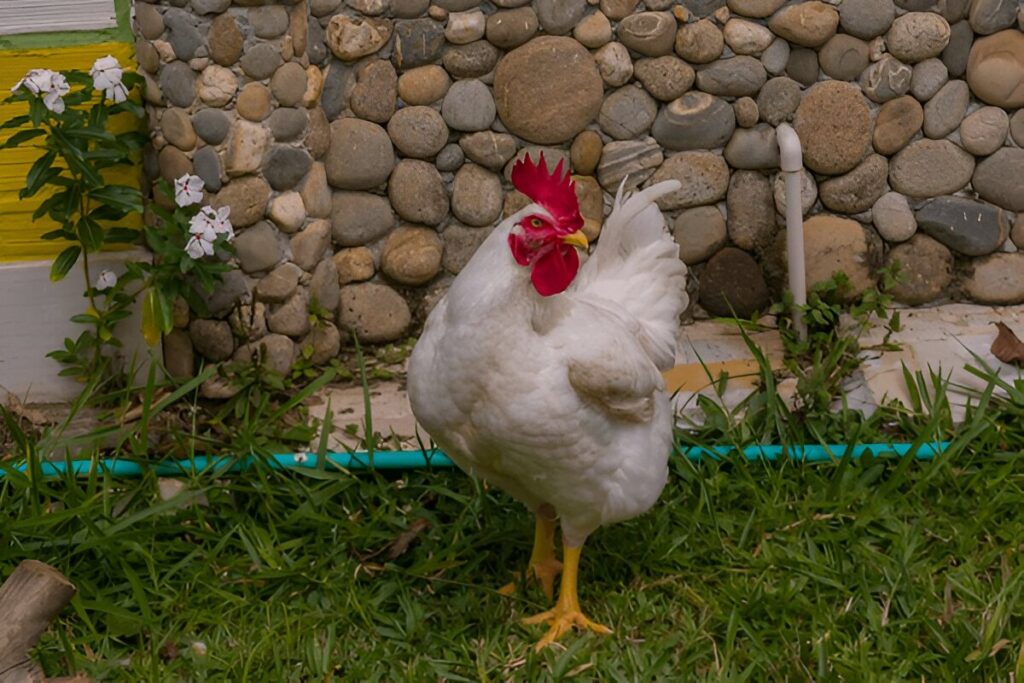
If you’re looking to raise chickens for meat, the Cornish Cross is likely at the top of your list. Known for their rapid growth and high meat yield, these birds dominate the poultry industry and backyard farms alike.
But what makes them so popular, and are they right for your flock? In this guide, we’ll explore the facts, benefits, and challenges of raising Cornish Cross chickens, backed by verified data and expert insights.
What Are Cornish Cross Chickens?
The Cornish Cross (also called Cornish-Rock or Broiler) is a hybrid breed developed in the 1950s by crossing Cornish chickens with White Plymouth Rocks.
Bred specifically for meat production, they grow faster and larger than any heritage breed, reaching market weight in just 6–8 weeks.
Key Traits of Cornish Cross Chickens
- Appearance: Broad-breasted, white-feathered, with yellow skin and legs.
- Growth Rate: Gains 1.5–2 lbs per week under optimal conditions.
- Lifespan: Typically raised for 6–10 weeks; rarely kept long-term due to health risks.
The History of Cornish Cross Chickens
Developed in the U.S. during the post-WWII era, the Cornish Cross was engineered to meet rising demand for affordable, high-quality meat. By combining the muscular build of Cornish chickens with the size of White Plymouth Rocks, breeders created a bird that could reach 5–6 lbs in 6 weeks—a game-changer for commercial poultry.
Did You Know?
Today, Cornish Cross chickens account for over 90% of chickens raised for meat in the U.S., according to the National Chicken Council.
Pros and Cons of Raising Cornish Cross Chickens
Advantages
- Rapid Growth:
- Reaches processing weight (5–6 lbs) in 6 weeks.
- Efficient feed conversion: 2 lbs of feed per 1 lb of weight gain.
- High Meat Yield:
- Dresses out to 70–75% of live weight (compared to 60% for heritage breeds).
- Large breast meat portion, ideal for grilling or roasting.
- Low Cost:
- Chicks cost 3–3–5 each, making them budget-friendly for bulk orders.
Challenges
- Health Risks:
- Rapid growth strains the heart, joints, and legs. Up to 5% may develop mobility issues.
- Prone to ascites (fluid buildup) and sudden death syndrome.
- Limited Foraging Ability:
- Less active than heritage breeds; prefer eating over roaming.
- Short Lifespan:
- Rarely survive past 12 weeks due to organ failure.
How to Raise Cornish Cross Chickens: Fact-Checked Care Guide
1. Housing Requirements
- Space: Provide 1–1.5 sq ft per bird indoors; overcrowding increases disease risk.
- Bedding: Use absorbent materials like pine shavings to prevent breast blisters.
- Temperature: Keep chicks at 95°F in Week 1, reducing by 5°F weekly until 70°F.
Pro Tip:
Avoid wire floors—they can damage the birds’ keel bones.
2. Feeding for Optimal Growth
- Starter Feed (Weeks 0–3): 20–24% protein crumble.
- Grower Feed (Weeks 4–6): 18–20% protein pellet.
- Avoid Overfeeding: Restrict feed after Week 4 to slow growth and reduce leg issues.
Sample Feeding Schedule:
| Age | Feed Type | Amount Per Bird/Day |
|---|---|---|
| 0–3 weeks | High-protein crumble | Free-choice |
| 4–6 weeks | Grower pellet | ½–¾ lb |
Supplements:
- Add probiotics to support gut health.
- Provide grit if offering whole grains.
3. Health Management
- Leg Issues: Add electrolytes to water and provide padded flooring.
- Ascites Prevention: Ensure proper ventilation to reduce ammonia buildup.
- Daily Checks: Remove lethargic birds immediately to prevent cannibalism.
Cornish Cross vs. Heritage Meat Breeds
| Breed | Growth to 5 lbs | Feed Efficiency | Foraging Ability | Lifespan |
|---|---|---|---|---|
| Cornish Cross | 6 weeks | 2:1 | Low | 6–10 weeks |
| Freedom Ranger | 9–11 weeks | 2.5:1 | Moderate | 1–3 years |
| Jersey Giant | 16–20 weeks | 3:1 | High | 5–8 years |
Key Takeaway:
The Cornish Cross is unmatched for efficiency but lacks the hardiness and longevity of heritage breeds like Freedom Rangers.
Ethical Considerations
Welfare Concerns
- Rapid Growth: Their genetics prioritize muscle over organ development, leading to heart failure in older birds.
- Limited Mobility: Over 30% may struggle to walk by Week 8, per a 2020 University of Arkansas study.
Humane Practices
- Process Early: Harvest at 6–8 weeks to minimize suffering.
- Avoid Free-Range Myths: Cornish Cross rarely thrive in free-range setups due to low activity levels.
FAQs About Cornish Cross Chickens
Q: Can Cornish Cross chickens reproduce?
A: No. They’re hybrids and typically sterile. Breeders must cross Cornish and White Plymouth Rocks to produce them.
Q: Are they good for backyard flocks?
A: Yes, but only for meat purposes. They’re not suitable as pets or egg layers.
Q: How much space do they need?
A: Indoors: 1–1.5 sq ft/bird. Outdoors: 2–3 sq ft in a secure run.
Q: Can I raise them organically?
A: Yes, but growth will slow. Use certified organic feed and avoid antibiotics.
Q: Why do they sit down so much?
A: Rapid muscle growth strains their legs. Provide low roosts (6–8 inches) or padded resting areas.
Q: Do they need vaccinations?
A: Commercial farms vaccinate for Marek’s disease, but backyard growers often skip this.
Q: What’s the best processing method?
A: Use a sharp knife or cone system for quick, humane slaughter. Follow USDA guidelines.
Q: Can they live with other chicken breeds?
A: Not recommended. Their sedentary nature clashes with active breeds.
Ready to Start Your Meat Flock?
For personalized advice on raising Cornish Cross chickens, reach out to our experts at Chickiq.com. We’ll help you balance efficiency with ethical practices!
